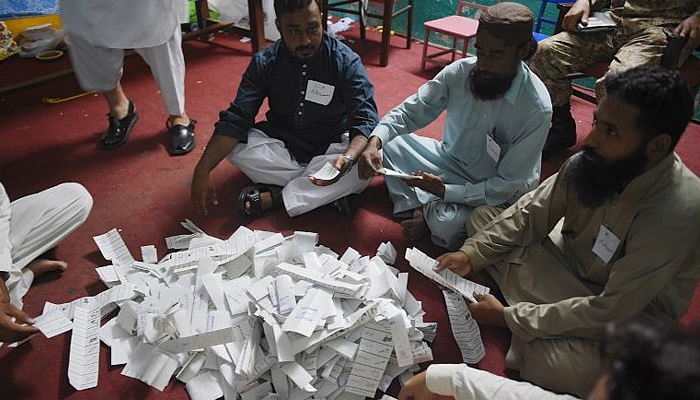What does Election 2024 look like?
In its latest press release, the ECP has given a tentative timeline for the general elections – January 2024. The fact that the ECP has not given an exact schedule makes many believe that elections might not happen around these dates either.
Given this uncertainty, the election campaign and the overall election mood is yet to descend in the cities and villages of Pakistan. From pollsters’ perspective as well, given this uncertainty, clear predictions are difficult. To use the weather analogy, given the fast-changing weather, weather predictions are at best murky. However, over the past four decades of election analysis has given us some clues about what we can expect, and this article aims to shed light on some.
First, the main power-yielders in the upcoming general elections remain political and nonpolitical forces. In a usual democracy, elections would be solely decided based on popular vote and the mechanics aligned to it – for example, political parties and their internal elections.
In Pakistani-style democracy, nonpolitical actors are as important. Many have theorized about Pakistani democracy as a pretorian democracy, where nonpolitical actors jealously guard who gets to participate in the election but also what the outcome of the general election would be. The usual refrain is that the military is the main nonpolitical actor, but I believe over the recent decades the judiciary as well as civil bureaucracy are other important and pivotal players in this equation.
Unfortunately, the 2024 general elections will be no different from the previous 11 elections: there is a general election in which approximately 100 million voters will be allowed to vote but their choices would be restricted to what the nonpolitical actors would allow. Many therefore rightly argue the need for this contest if both the process and the outcome are mediated if not determined by nonpolitical actors. The merits or demerits of this debate aside, as we watch the unrolling of General Election 2024, we should be clear-headed about the ritual of elections and how far or close it is to what the constitution of 1973 dictated.
Second, within the political actor’s space, the main contenders remain the old faces of Pakistani politics. The front-runner remains Imran Khan, followed by Nawaz Sharif, and followed by Asif Zardari. Together these three faces and the parties they represent took 31 per cent, 25 per cent and 15 per cent of the total votes cast in 2018. In other words, 71 per cent of all the votes cast belonged to these three individuals and their parties (that they either created or inherited).
If Election 2024 were to happen free and fair, we are likely to have not much of a different outcome in terms of how heavily three personalities would dominate the politics of the world’s fifth largest country. There can be changes in terms of vote proportions (for example, the PTI can win more than 31 per cent and the PML-N can win less than 25 per cent) but the stark fact would remain: that three parties represented and encapsulated by three leaders will be the choices the electorate would have.
Third, in case – and which appears to be increasingly the situation – the PTI is denied a level playing field, then Election 2024 can throw up new actors as well as unexpected gains and losses. Again , disallowing a political party – let alone one of the largest political parties – or its leader cannot and must never be endorsed without any legal judgment and I have no intentions of doing that. However, as an analyst it’s crucial to distance oneself and predict what would be the outcome if this were to happen. Within the cornering of PTI options each of the options throws up potentially different scenarios.
First, if Imran Khan is kept in jail (as was the case with Nawaz Sharif in the 2018 election) and the party is given a relatively free hand to contest election, I would this this the minus-ones scenario (a tried and tested formula from the establishment rulebook and successfully applied to the MQM and PML-N and tried multiple times on the PPP). My analysis of the previous and current public pulse suggests that this would only narrow down the gap between the PML-N and PTI, but the PTI would continue to be ahead and at best we would see a replication of the 2018 general election results.
Second, if Imran Khan is not allowed to contest and there is repression of PTI leaders and difficulty in issuing tickets, a scenario I call 'minus all’, and if it is done in the same fashion as was the case in 2018 with the PML-N, this could prove to be a lethal blow to the PTI. Lastly, and I think this is less likely to happen, the option is to remove the PTI from the electoral choices altogether, a scenario I call as 'No PTI' or 'Minus PTI'. This would be very difficult to pull off and would create an assembly that would be weak in legitimacy even after being born.
For scenarios 2 and 3, the more interesting question would be who gains with the ‘forced collapse’ of the PTI. One thing is quite clear: the largest casualty of scenarios 2 and 3 would be turnout and in turn the overall legitimacy of the electoral outcome. A major beneficiary of the forced exit of the PTI would be the TLP. The 2018 elections saw the rise of the TLP as a party that spoiled the votes of the PML-N. On the day of election, as many as 50 per cent of TLP voters claimed that they had voted for the PML-N in the 2018 general election. In 2024, if scenario 2 or 3 is unfolded, the TLP would now consolidate its vote and attract a major voter base from the PTI. This would be mainly in Punjab and its semi-urban towns, but it would be enough to make the TLP a major seat puller.
Unlike other analysts, even if PTI voters are forced to stay home, the likelihood of the PML-N regaining its lost position in Punjab is implausible and simply not how the voter blocs work. The vote the PML-N lost, and which went to the PTI, is now only going to go to another resistance and anti-PMLN party – the TLP.
The second group that can be minor beneficiaries of the 2nd and 3rd scenarios are the two new parties launched by Jehangir Tareen and Pervaiz Khattak respectively. There are others on the horizon like the one suggested by Miftah Ismail, Shahid Khaqan Abbasi and Mustafa Nawaz Khokhar. Together these three parties (if they can work together) can also pose a threat to not just the PTI but also the PML-N and PPP’s politics in Punjab. However these new parties fully replacing the PTI or attracting a bulk of its vote in just a few months would be difficult to imagine.
I would end on a more sober note. Election 2024 comes at one of the worst moments in national history. The economic collapse especially reflected in the hyperinflation and unemployment figures, the collapse of the legitimacy of authority as reflected by the May 9 incidents and repeated violation of the constitution as is with the case of adjournment of provincial assembly elections and now with National Assembly elections. Unfortunately, none of the political or nonpolitical actors in the runup to the 12th general election of Pakistan seem to realize the gravity of the situation and all sides seem to be replicating what they have done for the past 11 elections. Voters in this country and the conditions of the state of Pakistan require a major change which doesn’t seem to be on the horizon.
The writer is a political science student with a degree from SOAS, London.
-
 Jason Momoa Cherishes Hosting Ozzy Osbourne's Final Gig Ahead Of His Death
Jason Momoa Cherishes Hosting Ozzy Osbourne's Final Gig Ahead Of His Death -
 Real Reason Timothee Chalamet Thanked Kylie Jenner At Awards Revealed
Real Reason Timothee Chalamet Thanked Kylie Jenner At Awards Revealed -
 Will King Charles Attend Funeral Of Prince Philip's First Cousin, Princess Irene?
Will King Charles Attend Funeral Of Prince Philip's First Cousin, Princess Irene? -
 'Furious' Prince William Wants Andrew As Far Away As Possible
'Furious' Prince William Wants Andrew As Far Away As Possible -
 Blood Moon: When And Where To Watch In 2026
Blood Moon: When And Where To Watch In 2026 -
 Apple Foldable IPhone Tipped For 2026 Launch With A20 Pro Chip And C2 Modem
Apple Foldable IPhone Tipped For 2026 Launch With A20 Pro Chip And C2 Modem -
 Meghan Lends Credence To Reports Of Rift With Kim Kardashian On Chicago's Birthday
Meghan Lends Credence To Reports Of Rift With Kim Kardashian On Chicago's Birthday -
 Florida Woman’s Alleged Bid To Bribe Police Ends In Unexpected Discovery
Florida Woman’s Alleged Bid To Bribe Police Ends In Unexpected Discovery -
 James Van Der Beek Strongly Opposes The Idea Of New Year In Winter
James Van Der Beek Strongly Opposes The Idea Of New Year In Winter -
 Elon Musk’s Starlink Rival Eutelsat Partners With MaiaSpace For Satellite Launches
Elon Musk’s Starlink Rival Eutelsat Partners With MaiaSpace For Satellite Launches -
 Fans Feel For Leonardo DiCaprio As He Gets Awkwardly Snubbed: Watch
Fans Feel For Leonardo DiCaprio As He Gets Awkwardly Snubbed: Watch -
 Japan Launches The World’s First Trial To Extract Rare Earth Elements
Japan Launches The World’s First Trial To Extract Rare Earth Elements -
 Prince Harry Breaks Cover In California Amid Tension At Home With Meghan Markle
Prince Harry Breaks Cover In California Amid Tension At Home With Meghan Markle -
 ASAP Rocky Makes Massive Comeback With New Album
ASAP Rocky Makes Massive Comeback With New Album -
 Amanda Seyfried Unveils How Channing Tatum Teased Her On 'Dear John' Set
Amanda Seyfried Unveils How Channing Tatum Teased Her On 'Dear John' Set -
 Blue Moon 2026: Everything You Need To Know
Blue Moon 2026: Everything You Need To Know




